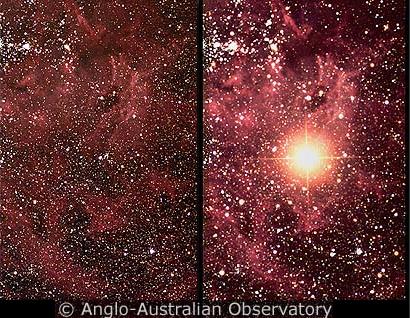|
|
 Supernova 1987A in the Large Magellanic Cloud (a satellite galaxy of the Milky Way, around 160000 light years away). The righthand image shows the supernova: on the left is the same region of the LMC before the star (a blue supergiant called Sanduleak -69 202, visible in the centre of the image) blew up. This was actually a rather faint supernova: because the star was a compact blue supergiant rather than an extended red supergiant, less gravitational potential energy was lost as it collapsed. It is the nearest star to go supernova in modern times, and the only one for which the pre-explosion star had been catalogued and studied. Image taken by David Malin of the Anglo-Australian Observatory.
Supernova 1987A in the Large Magellanic Cloud (a satellite galaxy of the Milky Way, around 160000 light years away). The righthand image shows the supernova: on the left is the same region of the LMC before the star (a blue supergiant called Sanduleak -69 202, visible in the centre of the image) blew up. This was actually a rather faint supernova: because the star was a compact blue supergiant rather than an extended red supergiant, less gravitational potential energy was lost as it collapsed. It is the nearest star to go supernova in modern times, and the only one for which the pre-explosion star had been catalogued and studied. Image taken by David Malin of the Anglo-Australian Observatory.
|
Summary of Lecture 5 – Star Death
- The lifetimes of stars depend strongly on their initial mass:
- most stars are about half as massive as the Sun and have main-sequence lifetimes much longer than the age of the Universe: they have hardly started to evolve yet;
- a star of the Sun's mass has a lifetime a little shorter than the age of the Universe: the first solar-mass stars to form have now died;
- massive stars such as Rigel or Deneb have very short lifetimes, only a few million years: almost all the massive stars that ever lived have now died.
- Fusion of elements heavier than helium becomes steadily more difficult (and less profitable):
- the higher positive charges mean that much higher temperatures are needed to overcome the electrical repulsion between nuclei;
- the relative mass difference between initial and final states is less, so less energy is generated per kilogram of material fused.
- Allowing for mass loss in the giant stages, stars of mass up to about 8 times the Sun's mass never get hot enough to fuse elements heavier than helium:
- they expel their outer layers, especially towards the end of helium fusion, in a stellar wind;
- the expanding gas cloud produced becomes a planetary nebula (with an emission line spectrum, because it is a low-density gas heated by the intense ultraviolet radiation from the central carbon core);
- the remaining, very hot, carbon core of the original star (typically about 0.5-1 solar mass) becomes a white dwarf;
- as the white dwarf is not generating energy, it will gradually cool and fade to invisibility.
- More massive stars do fuse heavy elements, producing an "onion" structure with layers of successively heavier elements:
- these heavy-element-fusion stages are very short-lived (a few days at the end!);
- the formation of a core of iron marks the end: iron fusion does not generate energy (iron has the least mass per nucleon of any element);
- when the iron core grows too massive to support itself against gravity, it will inevitably collapse.
- The collapse of the iron core results in the explosive ejection of the outer layers of the star in a supernova:
- electrons combine with protons to form neutrons;
- the resulting material is like a single atomic nucleus (recall that atoms are mainly the empty space between electrons!);
- these neutron stars typically weigh about 1.5 times as much as the Sun and are about 20 km across;
- neutron stars spin very fast and have strong magnetic fields: the magnetic field and strong gravity of the neutron star can channel a beam of charged particles out of the magnetic poles of the star;
- if the magnetic and spin axes are not aligned this results in a "lighthouse beam" effect, creating a flashing source of radio waves: a pulsar;
- many pulsars have been observed in our Galaxy: the most famous (the Crab pulsar) is associated with a supernova seen by the Chinese in 1054.
- The conditions in and shortly before the explosion allow the formation of very heavy elements (heavier than iron):
- slow addition of neutrons (s-process) occurs from the helium fusion stage onwards and produces isotopes close to the line of maximum stability, since any unstable isotopes decay before the next neutron hits;
- rapid addition of neutrons (r-process) occurs in the supernova itself and produces extremely unstable super-neutron-rich
isotopes (because many neutrons hit each nucleus)—these subsequently
decay to nuclei which tend to be on the neutron-rich side of the s-process
line;
- a few rare neutron-poor isotopes are not produced by adding neutrons, but by having neutrons knocked out by energetic photons (p-process) – this produces neutron-poor isotopes.
Web links
Go back to main page
Go on to Summary for Lecture 6
|
Hicks Building, Hounsfield Road, Sheffield S3 7RH, UK
|